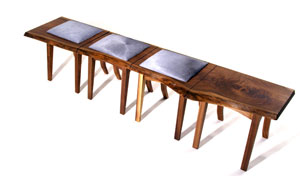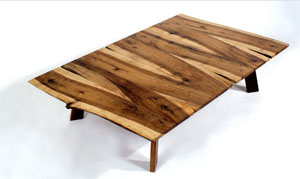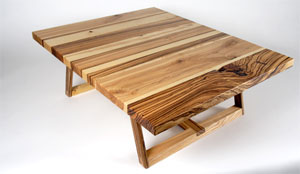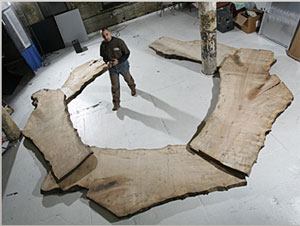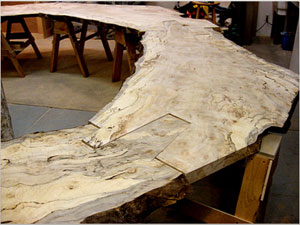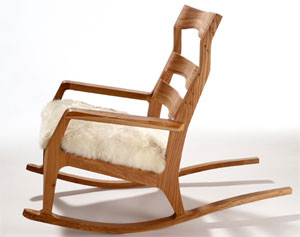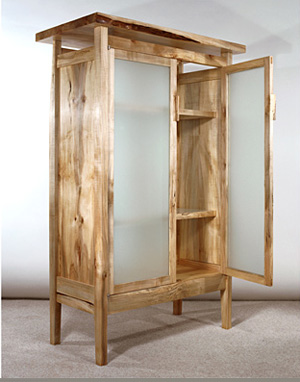
Eric Manigian has found his creative style heavily influenced by his experiences in Japan and with traditional Japanese tools and practices. He studied sculpture at the Pratt Institute in New York, then spent a year in Japan studying meditation before returning to the U.S., where he looked up one of his prior instructors.
After learning about Japanese hand tools through workshops with Japan-born Toshio Odate, Eric became involved with the Timber Framer’s Guild. The nonprofit organization focused on historic building techniques was involved with a project in which they brought some high-level Japanese carpenters to the U.S. to build tea houses in the Monterey, California, area. That project occurred around the same time that Larry Ellison, a founder of software company Oracle, was having a Japanese-style complex built for himself in California. Although Eric didn’t participate in the Ellison project, both of those experiences “brought a lot of people into the traditional Japanese architecture and building methods,” he said. “There was a band of North American people who got fascinated with Japanese tools and teachings and aesthetics.”
Eric went on to study architecture after participating in the Timber Framer’s Guild, and did later participate in a trip sponsored by San Francisco-based Hida Tools to an annual Japanesecarpenters’ convention, which also included tours of toolmakers’ shops. Eric says he has a strong appreciation for the traditional Japanese tools such as saws, hand planes, chisels and hammers. “Their hand plane is really quite beautiful,” he said. “I think a lot of Westerners are getting themselves chisels and saws, but the hand plane takes more knowledge to set it up right. I like the feel of white oak rather than the Western hand plane’s steel, and the easy adjustment with a hammer rather than turning a dial in and out.”
Eric also cites the laminations of steel used in the metal areas of Japanese tools — “their harder steel is harder than American, and their softer steel is softer than American,” he says — as appealing to him. “Their toolmakers are really tuned in to the simplicity and weight balance of those tools. Japan is one place that’s always honored the craftsmanship of the maker and the user, and the dialogue together has produced a very fine working relationship.”
“They’ve had several hundred years of refining culture, and it’s a sensibility I just sort of strongly gravitate towards.”
Much of Eric’s inspiration for his own designs comes from “a quiet observation of the wood itself. If you’re bringing a perspective of respect for the material and the origin of the material,you slow down and make quiet observations.”
For instance, Eric says his “Fold” series is a sculptural investigation of wood as paper and paper as wood; whereas his “Bandwidth” series was “derived from an intimate observation of the inherent patterns in the wood’s grain itself. I just exploded it.”
While much of Eric’s current work has been furniture, lately he says he’s found himself exploring more sculptural ideas. While he doesn’t actively create many designs that are specifically for architecture, Eric says he finds all three areas — furniture, sculpture and architecture — “feeding each other in terms of form and how they express ideas and connect to each other.”
His “Enso Table,” project, for instance, a 15-foot diameter round table made of five sequential slabs of spalted maple joined with pegged scarf joints, has an architectural quality to it. Eric found the spalts reminiscent of calligraphy: “Enso” is the Japanese word for the ink-brushed circle which embodies the Sanskrit “shunyata” or “emptiness.” Eric considers the table his epic piece.
When you’re dealing with three-dimensional space, Eric said, “it gets hazy” to distinguish among architecture, furniture and sculpture. He prefers to “erase those borders,” and also to tell the story of Isamu Noguchi, a Japanese sculptor who also designed lamps, children’s playgrounds, parks and more. “I like to cite him to challenge the snotty idea that ‘Art’ with a capital ‘A’ is somehow practiced with more intelligence than design. I ask, ‘Was Naguchi less intelligent when he was designing a lamp or a coffee table than when he was carving stone?'”
As for his own materials, Eric says, “for furniture, I’ve mostly worked in walnut. In architecture, I like cedar.” While he works with a couple of small milling operations to use wood from downed trees, Eric tries to concentrate is work on another face of “being green,” or environmental awareness: “Nothing is green if it ends up in a landfill,” he said. “If all the processes that go into construction produce a pretty bad project, people will throw it out eventually.”
After having a client indicate that they were thinking about their children, who would inherit the furniture Eric was building, at the time of choosing the design, Eric says he now tries to “build a piece with a multigenerational view. I feel that’s truly an overlooked aspect of green intention.” While he still wants to “take chances and be daring” in his designs, “you feel a different obligation,” he said.
In another instance of responding to the next generation, Eric said he often finds himself responded to queries from younger people who ask how to get started in the design business. “I tell them, ‘Build the piece you want to be commissioned for, because no one else can imagine what you’re imagining,'” he said.
As for his own works of imagination, Eric said, “I like the grounded-ness of making something to serve people: the sincerity and integrity of craftsmanship, the sensuality of materials and the challenge of trying to make something with life.”
